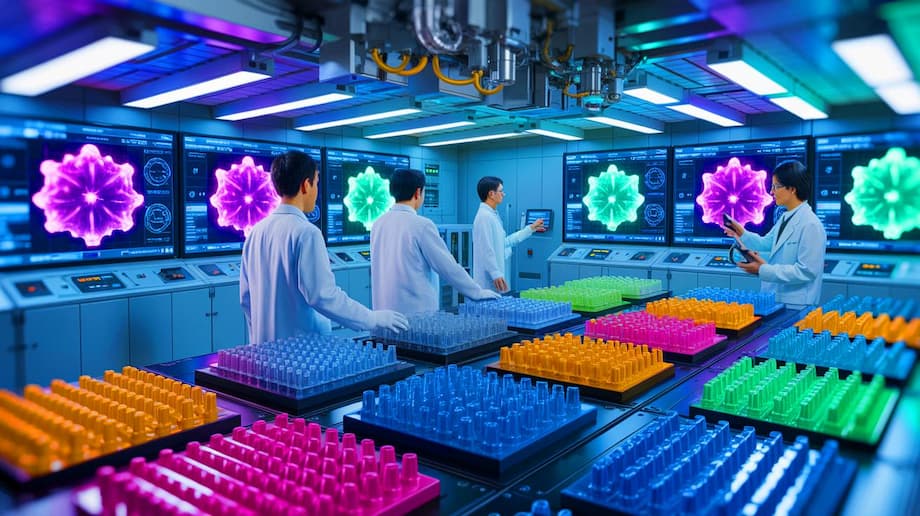Japan’s Electron Beam Innovation: A Turning Point for Teflon Recycling
In a world grappling with mounting plastic waste and the environmental menace of so-called “forever chemicals,” a team of Japanese researchers has achieved a breakthrough that could reshape the future of recycling. By harnessing the power of electron beams, scientists at Japan’s National Institutes for Quantum Science and Technology (QST) have developed a method to efficiently recycle polytetrafluoroethylene (PTFE)—better known as Teflon—cutting energy use in half and offering a viable path toward a circular economy for high-performance plastics.
- Japan’s Electron Beam Innovation: A Turning Point for Teflon Recycling
- What Makes PTFE (Teflon) So Challenging to Recycle?
- How Does Electron Beam Recycling Work?
- Why Is This Breakthrough So Significant?
- Global Context: Tackling Forever Chemicals and Plastic Waste
- Environmental and Economic Impact
- Scientific Insights: Understanding the Process
- Broader Implications: Toward a Circular Economy for Plastics
- In Summary
PTFE is prized for its non-stick, heat-resistant, and chemically inert properties, making it ubiquitous in cookware, electronics, medical devices, and industrial applications. Yet these same qualities have made it nearly impossible to recycle, leading to vast amounts of Teflon waste accumulating in landfills and the environment. The Japanese breakthrough, which combines moderate heat with electron beam irradiation, promises to change that narrative.
What Makes PTFE (Teflon) So Challenging to Recycle?
PTFE’s chemical structure is dominated by strong carbon-fluorine bonds, which are among the most robust in organic chemistry. This gives Teflon its legendary durability and resistance to heat and chemicals, but also means it does not break down easily—either in nature or in conventional recycling processes. PTFE belongs to the family of per- and polyfluoroalkyl substances (PFAS), often dubbed “forever chemicals” because of their persistence in the environment and potential to contaminate water, soil, and even human bloodstreams.
Traditional recycling methods for PTFE, such as pyrolysis, require extremely high temperatures (600–1000°C or 1112–1832°F) and massive energy input. These processes are not only costly but also environmentally taxing, producing significant carbon emissions and often failing to fully decompose the material. As a result, most Teflon products—like old frying pans and industrial coatings—end up as permanent waste.
How Does Electron Beam Recycling Work?
The Japanese team’s method centers on exposing PTFE to a powerful electron beam while heating it to a much lower temperature than traditional methods. Specifically, the process involves heating PTFE to 370°C (698°F) in air and then irradiating it with a 5-megagray (MGy) electron beam. This combination triggers a cascade of molecular changes, breaking the stubborn carbon-fluorine and carbon-carbon bonds and converting the solid plastic into gaseous products.
At room temperature, electron beam irradiation alone decomposes only about 10% of PTFE. However, when the temperature is raised to 270°C (518°F), the decomposition rate jumps to 86%, and at 370°C (698°F), the process achieves complete (100%) decomposition. The main products are oxidized fluorocarbons and perfluoroalkanes—gases that can be captured and reused as raw materials in the chemical industry, supporting a circular resource model.
This approach marks a dramatic improvement over pyrolysis, halving the energy required for recycling from the conventional 2.8–4 megawatt-hours (MWh) per ton to just over 2 MWh per ton. According to QST’s official press release, this translates to a 48% reduction in energy consumption and a similar cut in CO₂ emissions, making the process both economically and environmentally attractive.
What Happens at the Molecular Level?
Electron beams are a form of ionizing radiation that can penetrate deep into materials, generating free radicals and breaking chemical bonds. In the case of PTFE, the irradiation not only decomposes the polymer but also induces changes in its crystalline structure. Analytical techniques such as thermogravimetric analysis (TGA), scanning electron microscopy (SEM), and X-ray diffraction (XRD) have shown that high-temperature irradiation increases the size of PTFE crystallites and accelerates the production of oxidized gaseous products. This molecular restructuring is key to the process’s efficiency.
Radiation-induced cross-linking and degradation are well-known phenomena in polymer science. While cross-linking typically enhances a polymer’s stability, in this context, the electron beam’s energy is harnessed to break down the PTFE chains, overcoming the material’s notorious resistance to decomposition.
Why Is This Breakthrough So Significant?
The implications of this innovation extend far beyond Teflon recycling. PTFE and other fluoroplastics are essential to modern industry, but their environmental footprint is substantial. Japan, for example, relies entirely on imported raw materials for fluoroplastics, and the life-cycle CO₂ emissions of these materials are much higher than those of conventional plastics. By enabling efficient recycling and resource recovery, the electron beam method addresses both resource security and environmental sustainability.
Moreover, the process offers a safer alternative to chemical recycling methods that can generate hazardous byproducts or require toxic reagents. The gaseous products of electron beam decomposition can be collected and purified for reuse, minimizing waste and supporting a closed-loop system.
Dr. Akira Idesaki, who led the QST research team, emphasized the broader impact of their work:
“By applying heat during irradiation, we were able to reduce the energy required to decompose PTFE by 50% compared to traditional methods, making it much more feasible to recycle fluoropolymers on a large scale.”
This breakthrough could pave the way for industrial-scale recycling of PTFE and similar materials, transforming waste management practices in sectors ranging from electronics to automotive manufacturing.
Global Context: Tackling Forever Chemicals and Plastic Waste
The Japanese achievement comes amid a global push to address the environmental and health risks posed by PFAS and other persistent plastics. International initiatives, such as the International Atomic Energy Agency’s (IAEA) NUTEC Plastics program, are exploring the use of nuclear and radiation technologies to track, degrade, and recycle plastic waste across Asia and the Pacific. Countries like Malaysia are already experimenting with electron beam irradiation to convert PTFE waste into industrial micropowders, while Indonesia and the Philippines are using radiation to enhance the properties of recycled plastics for construction and manufacturing.
Other innovative approaches are also emerging. Researchers at the University of Leicester in the UK have developed a sound wave technique to separate PFAS membranes from precious metals, offering a simple, scalable, and chemical-free alternative for recycling fuel cells and other complex products. These complementary efforts underscore the importance of technological diversity and international collaboration in the fight against plastic pollution.
Environmental and Economic Impact
The environmental benefits of electron beam recycling are clear: reduced energy consumption, lower greenhouse gas emissions, and the potential to divert vast quantities of PTFE waste from landfills and incinerators. The process also addresses the urgent need to prevent hazardous chemicals from leaching into ecosystems and contaminating water supplies—a growing concern as PFAS are detected in everything from Arctic ice to human blood.
On the economic front, the technology could make PTFE recycling commercially viable for the first time. By slashing energy costs and producing valuable chemical feedstocks, the method offers a compelling business case for industries that generate PTFE waste. Japan’s reliance on imported fluoroplastics further strengthens the incentive to develop domestic recycling capabilities, enhancing resource security and supporting national sustainability goals.
Challenges and Next Steps
While the laboratory results are promising, scaling up the electron beam process for industrial use will require further research and investment. Key challenges include optimizing the collection and purification of gaseous products, integrating the technology into existing waste management systems, and ensuring safety and regulatory compliance. The QST team is actively seeking industry partners to pilot the technology and refine the process for commercial deployment.
Future research will also explore the application of electron beam recycling to other types of fluoropolymers and high-performance plastics, potentially expanding the impact of this innovation across multiple sectors.
Scientific Insights: Understanding the Process
To appreciate the significance of the Japanese breakthrough, it helps to understand the science behind electron beam-induced decomposition. When high-energy electrons strike PTFE, they generate free radicals—highly reactive molecular fragments that can break chemical bonds and initiate chain reactions. The presence of oxygen during irradiation further accelerates the breakdown, leading to the formation of oxidized fluorocarbons and other gaseous products.
Thermal analysis techniques, such as thermogravimetric analysis (TGA) and differential scanning calorimetry (DSC), reveal the thermal stability and decomposition behavior of PTFE fibers. These methods show that PTFE remains stable up to high temperatures, but under the combined influence of heat and electron irradiation, it undergoes rapid weight loss and structural transformation. The resulting gases can be analyzed and captured for reuse, closing the loop on resource recovery.
Radiation processing is not new to polymer science, but its application to PTFE recycling represents a novel and highly effective use of the technology. The ability to control the degree of decomposition and tailor the process to specific industrial needs makes electron beam recycling a versatile tool in the quest for sustainable materials management.
Broader Implications: Toward a Circular Economy for Plastics
The Japanese electron beam method exemplifies the kind of innovation needed to transition from a linear “take-make-dispose” model of plastic use to a circular economy, where materials are continually reused and recycled. By turning a stubborn waste product into valuable chemical feedstocks, the process not only reduces environmental harm but also creates new economic opportunities.
As governments, industries, and researchers worldwide confront the twin challenges of plastic pollution and resource scarcity, technologies like electron beam recycling offer a blueprint for sustainable progress. The integration of such methods into mainstream recycling systems could dramatically reduce the environmental footprint of plastics, support the development of green industries, and help safeguard public health.
In Summary
- Japanese researchers have developed an electron beam method that fully decomposes PTFE (Teflon) at lower temperatures, halving energy use compared to traditional recycling.
- The process converts solid PTFE into reusable gaseous products, supporting a circular economy and reducing environmental impact.
- Electron beam recycling addresses the persistent problem of “forever chemicals” by breaking down robust carbon-fluorine bonds in PTFE.
- The technology offers significant reductions in CO₂ emissions and energy costs, making large-scale recycling of high-performance plastics commercially viable.
- Global efforts, including sound wave and radiation-based techniques, are complementing this breakthrough to tackle plastic waste and PFAS pollution worldwide.
- Scaling up the technology and integrating it into existing waste management systems will be key to realizing its full potential.












